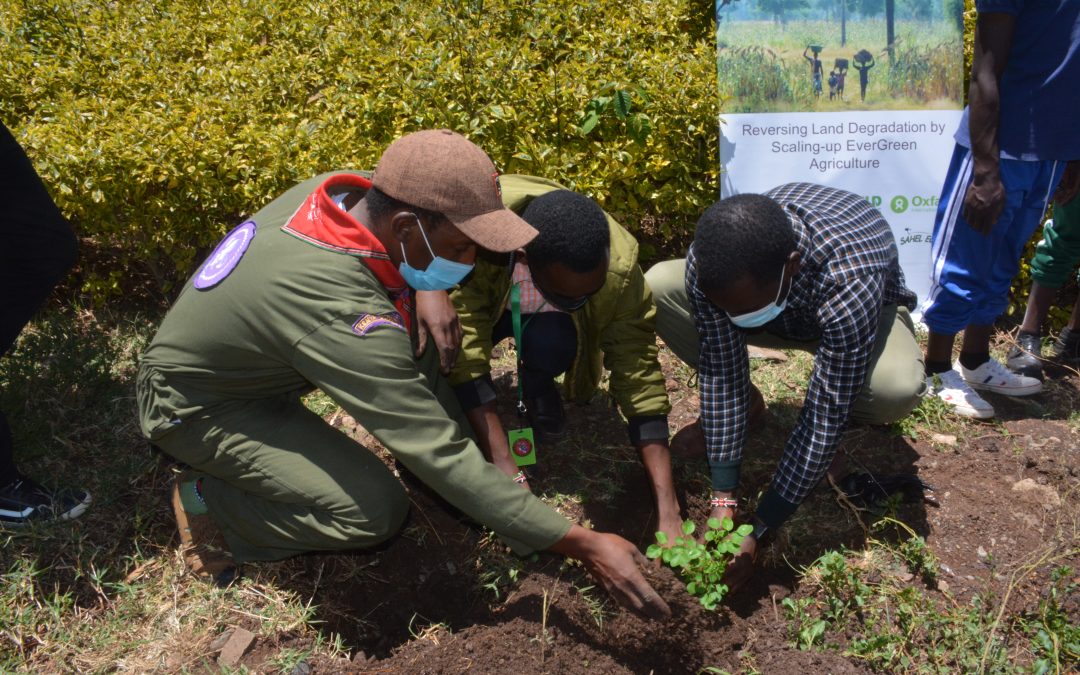As the current and future stewards of land restoration, youth need to act and speak up as advocates of land restoration.
By Marion Aluoch
Create more opportunities for decent meaningful work! Leverage technology! Incubate businesses! Involve youth in meaningful landscape restoration! For long-term sustainability, youth must own land! Sport, especially football, is a gateway to engaging youth! Remember that one strategy cannot fit all youth; different strategies must be developed for each group!
These are some of the key recommendations that emerged from a multi-country learning event led by Regreening Africa about empowering and mainstreaming youth in land restoration, which focused on what is required for youth to effectively run sustainable tree-based ventures as well as increasing their understanding of the many benefits and opportunities that trees and land provide.
Mark Kagwe, founder and managing director of NENDO, a digital service in Kenya, talked about technology and what we need to consider, noting that technology can be used to empower youth to engage in agribusiness and regreening initiatives. Sport is an excellent way to engage youth because they can combine learning and entertainment. However, he also stated that youth can use technology in a non-productive way, wasting their time and resources. But by building their capacity in internet use, they can use technology in meaningful ways.
He highlighted various platforms, explaining how to use them to reach out to young people and engage them in the restoration process.
‘Wowzi allows content creators to generate content; Wowzi advertises it and creates a market or business for them,’ he said by way of example. ‘There is also Jiji, which is creating dynamism in the value chain by providing a market for farmers’ products. WhatsApp has also revolutionized the way individuals share information, ideas, opportunities and sales with others.’
Other platforms include Facebook, where groups can be formed and market information shared. Blogs also enable content creators to document and share their work.
He also noted that businesses were also using other new technologies and innovations.
‘In Kenya, for example, there is M-Kopa, which sells solar kits and charges buyers on usage,’ he said. ‘Smartphone manufacturers have also taken notice and larger batteries are now available to optimize performance.’
Kagwe emphasised that when developing any digital intervention or engaging youth in technology, we must keep the following factors in mind: data, space and battery. To efficiently use data, young people must be engaged in meaningful ways; use lightweight applications that do not take up too much space; and use phones with longer battery life to maximize performance.
In Ghana, development of young people’s capacity includes training of trainers courses to empower them to engage with their communities. Bushfires are a common occurrence in Ghana, however, with training in skills such as fire management, young people can help sensitize communities to the dangers of bushfires.
‘Youth are very active and fast adopters of technology and they work better in groups, so understanding what they want and developing different strategies for different youth groups is critical,’ said Philip Atiim, senior programs officer for agriculture and coordinator for the Regreening Africa project with Catholic Relief Service Ghana.
Milton Oboke, co-founder and executive director of One Vision Kenya, expressed similar sentiments. He emphasized the importance of equipping youth with relevant skills through peer learning and empowerment.
‘We need to build youth capacity through training, extension services and agriculture to help tackle the problem of food insecurity,’ he said. ‘The youth must also own land to avoid conflicts of interest in utilization as some of them lease land, which is unsustainable. Peer-to-peer learning is also important as they visit each other to share experiences.’
In Cameroon, youth are involved in land restoration in a variety of ways, including movement building, mentoring and empowering other young people for climate decisions.
‘Involving youth in environmental conservation through school clubs, micro-enterprise programs and being in networks has aided in the completion of many restoration activities,’ said Ewi Lamma, an environmental and climate justice advocate. ‘These activities give them exposure, allow for knowledge sharing, and raise their status and standing in the community.’
It is evident that youth are involved in a variety of ways but how can their contributions to land restoration be measured? Mawa Karambiri, Sahel policy and technical engagement specialist, suggested ways to track youth engagement.
‘We need to assess youth engagement and expectations using quantitative and qualitative data collected by youth,’ said Karambiri. ‘There is a need to evaluate the nature of the activities used to engage youth, as well as the resources and outcomes. This information is gathered by the staff’s organization to ensure information triangulation through various services. Finally, we need to evaluate the level of support and commitment to youth engagement and development. This information is gathered by the community’s available social structures to contextualize the youth engagement process and outcomes.’
As the current and future stewards of land restoration, youth need to act and speak up as advocates of land restoration. As a result, it is critical to engage them in meaningful ways, to explore fresh and inventive ideas, and to keep the conversation going.
Watch: Empowering and mainstreaming youth in land restoration webinar
This story was produced with the financial support of the European Union. Its contents are the sole responsibility of Regreening Africa and do not necessarily reflect the views of the European Union.

